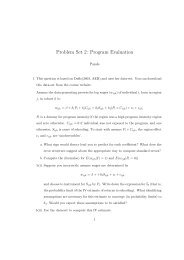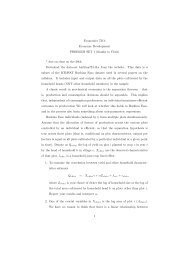The Expected Utility Model: Its Variants, Purposes, Evidence and ...
The Expected Utility Model: Its Variants, Purposes, Evidence and ...
The Expected Utility Model: Its Variants, Purposes, Evidence and ...
Create successful ePaper yourself
Turn your PDF publications into a flip-book with our unique Google optimized e-Paper software.
Schoemaker: <strong>The</strong> <strong>Expected</strong> <strong>Utility</strong> <strong>Model</strong> 541<br />
ex post rationalization) may well increase<br />
accordingly.8 It is beyond our scope to examine<br />
further the merits of positivistic<br />
<strong>and</strong> postdictive perspectives as they entail<br />
complex epistemological issues. Penetrating<br />
analyses on this topic were recently<br />
offered in books by Alex<strong>and</strong>er Rosenberg<br />
(1975) <strong>and</strong> Mark Blaug (1980).<br />
Finally, there exists a fourth perspective<br />
according to which EU theory is a prescriptive<br />
or normative model. Decision<br />
analysts <strong>and</strong> management scientists (implicitly)<br />
assume that human behavior is<br />
generally suboptimal. <strong>The</strong>ir goal is to improve<br />
decisions (prescriptive), for instance<br />
by using EU theory (normative). If so, the<br />
theory serves to advise which alternative(~)<br />
to select in complex decision situations<br />
on the basis of the decision maker's<br />
basic tastes <strong>and</strong> preferences. As outlined<br />
earlier these basic risk preferences are<br />
captured through a NM utility function.<br />
<strong>The</strong> complex options are then rank-ordered<br />
on the basis of expected utility.<br />
Each of the four EU purposes discussed<br />
above has its constituents, who would interpret<br />
empirical evidence on the EU<br />
model differently. For instance, evidence<br />
on axioms is relevant to the descriptive<br />
<strong>and</strong> prescriptive usages whereas predictions,<br />
preferably about real-world behavior,<br />
matter to the predictive or postdictive<br />
views. A complicating feature of the EU<br />
model as employed in economics <strong>and</strong> finance<br />
(e.g., Peter Diamond <strong>and</strong> Rothschild,<br />
1978) is that the assumption of EU<br />
maximization may have the following<br />
three important qualifiers. First, the theory<br />
is usually restricted to decisions that<br />
8Thi~is not to say that economic animal experiments<br />
advance non-falsifiable hypotheses. For instance,<br />
Raymond Battalio, et al. (1981)found in their<br />
experiments that pigeons engaged in insdcient substitution<br />
when compared to the Slutsky-Hicks theory.<br />
However, in some respecified model the observed<br />
behavior might well be "optimal." My<br />
concern is with the meta-postulate that all animal<br />
behavior is in some sense optimal, as this may lead<br />
to empirically vacuous theories.<br />
are important economically. <strong>Evidence</strong> on<br />
hypothetical decisions might thus be dismissed<br />
on grounds of having no significant<br />
economic consequence to the decision<br />
maker. Second, since the concern in economics<br />
is with market rather than individual<br />
behavior, only those individuals trading<br />
at the margin need to be EU<br />
maximizers. For instance, in busy traffic<br />
only a small portion of highway drivers<br />
need to change from slower to faster lanes<br />
(a type of arbitrage) for the lanes to move<br />
at the same speed eventually. Thus it often<br />
requires only a few rational persons for<br />
the market as a whole to behave rationally.<br />
Third, in economics, EU maximization<br />
is mostly assumed in competitive environments,<br />
where feedback enables<br />
people, over time, to improve their behavior.<br />
Hence, some history of learning <strong>and</strong><br />
struggle for economic survival are often<br />
assumed for the EU model as used in finance<br />
<strong>and</strong> economics (Alchian, 1950; Sidney<br />
Winter, 1964 <strong>and</strong> 1971).<br />
IV. Empirical <strong>Evidence</strong><br />
In recognition of the various purposes<br />
served by EU models, the present overview<br />
of empirical evidence is organized<br />
around four different approaches. Although<br />
some research studies could properly<br />
be discussed under several of these,<br />
they are mostly treated under just one category.<br />
a. Tests of EU Axioms<br />
<strong>The</strong> first EU axiom has two components:<br />
(1)for any choice people have a definite<br />
preference (including indifference), <strong>and</strong><br />
(2) preferences are transitive. In one of<br />
the first empirical tests of the EU model<br />
(1951) Frederich Mosteller <strong>and</strong> Philip Nogee<br />
found, however, that subjects on repeated<br />
measures of preference would not<br />
always give the same answers. <strong>The</strong>y subsequently<br />
conducted their research assuming<br />
stochastic rather than deterministic




